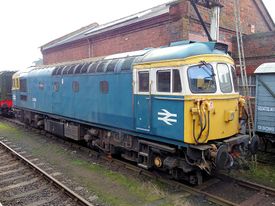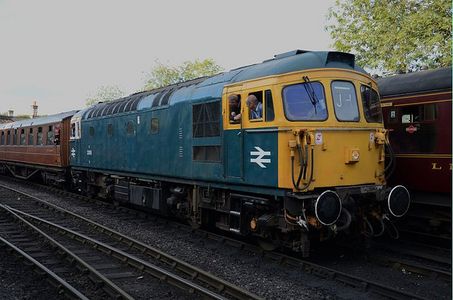BR Class 33 33108
| BR Class 33 33108 | |
|---|---|
 Class 33 No 33108 at Bewdley in 2020 | |
| Built By | Birmingham Railway Carriage and Wagon Company, Smethwick |
| Configuration | Bo-Bo |
| Power type | Diesel Electric |
| Status | In service |
| Loco Number | 33108 |
| Other Numbers | D6521 |
| History | |
| Built | 1960 |
| Designed By | Birmingham Railway Carriage and Wagon Company |
| Type | Class 33 |
| 1967 | Converted to push pull operation |
| 1993 | Withdrawn |
| 1996 | Preserved |
| 2002 | Named 'Vampire' |
| 2012 | Visited SVR for 2012 Diesel Gala |
| 2017 | Visited SVR for 2017 Diesel Gala and extended visit |
| Technical | |
| Length | 50ft 9" |
| Weight | 73t |
33108 is a BR Class 33 locomotive, owned by the Class 33/1 Preservation Company Ltd. 33108 first visited the SVR for the 2012 Diesel Gala, and again attended the Spring Diesel Festival in 2017. Following the latter, it has remained at the SVR for an extended stay, initially until at least May 2018 and later further extended.[1]
The Southern Region of British Railways ordered 98 locomotives from Birmingham Railway Carriage and Wagon Company (BRCW) of Smethwick, Birmingham (works numbers DEL 92-156, DEL 169-189 and DEL 157-168). The last 12 locomotives were 7 inches narrower, to enable working through the restricted tunnels of the Hastings line. All were delivered between 1960 and 1962 in standard BR loco green, most being repainted BR blue during the late 1960s and early 1970s. The locomotives were of a new design, based on the BRCW Type 2 (later Class 26), with a larger engine. They are powered by a Sulzer 8 cylinder in-line engine of 1,550 bhp, designated 8LDA. The main generator and the four traction motors were supplied by Crompton Parkinson, hence the class's 'Crompton' nickname. The class worked all kinds of duties on the Southern Region including passenger trains, for whey were the first BR diesel locomotives to have electric train heating. During 1967, 19 of the locomotives were fitted with push-pull equipment to enable them to haul 4-TC units on the unelectrified section from Bournemouth to Weymouth, and to carry warning lights and klaxons for boat trains on the road section of the Quay.[2] In the TOPS renumbering these were designated Class 33/1 and the Hastings line 'Slim Jims' Class 33/2. Electrification was extended to Weymouth in 1988 and the 33/1 sub-class displaced to wider duties.
Contents
33108 in service
D6521 was constructed at BRCW to works No. DEL113. It entered service at Hither Green in September 1960, and was reallocated to Eastleigh in 1963, where it remained for the rest of its working life.[3] During 1967 it was one of the locomotives fitted with push-pull equipment and so was renumbered 33108 on 1 January 1974.[4] The locomotive ended its life as depot shunter at Eastleigh, and remained in working order until withdrawn on 24 May 1993, being sold to the Class 33/1 Preservation Company in January 1997.[4]
33108 in preservation
The locomotive was moved to Crewe International Electric Depot for restoration, and attended the Crewe Depot open day on 3 May 1997 as a static exhibit. Restoration to working order at The Railway Age, Crewe (now the Crewe Heritage Centre) between 1997 and 1999, after which the locomotive was leased for five years to mainline operator Fragonset Railways. 33108 was named "Vampire" between 17 May 2002 and 25 April 2005, when it was returned from Fragonset Railways. An extended visit to the Swanage Railway occurred between 10 May 2005 and 21 June 2007, but 33108 was badly damaged in a collision on 16 November 2006. Repairs, including a full power unit overhaul, were performed at Barrow Hill, with test runs occurring on 21 March 2010.[4]
Since 2010, 33108 has attended numerous diesel galas across the country,[4] including the SVR in 2012 and 2017. Following the latter 33108 was invited for an extended stay at the SVR and, in addition to passenger duties, the locomotive was regularly used on Permanent Way trains and other duties following the departure of Class 20s D8059 and D8188.[5]
On 11 September 2020 it operated passenger trains with a '60' headcode on the window blinds, marking the 60th anniversary of its first introduction to traffic on 11 September 1960.
33108 was taken out of traffic in May 2021 to allow for traction motor replacement, a bodywork overhaul and repaint.[6] The work was substantially completed by early 2023, with the loco carrying Civil Engineers 'Dutch' livery.
On 9 July 2021 BR Class 31 31466 was collected from the Dean Forest Railway by 50049 Defiance and delivered to Kidderminster as cover for 33108.
See also
Diesel Locomotives visiting the SVR for galas
Locomotives running under different identities
Diesel Locomotives hired by the SVR
References
- ↑ SVR - Operational & non-operational diesel locomotives, accessed 14 January 2018
- ↑ Cromptons' history, BR Class 33 website (Retrieved 12 September 2020)
- ↑ Cromptons - BR Class 33 Locomotives - 33108, accessed 20 November 2017
- ↑ 4.0 4.1 4.2 4.3 Class 33/1 Preservation Company - History of 33108 (D6521), accessed 20 November 2017
- ↑ SVR Forum - Class 33 33108, accessed 20 November 2017
- ↑ Class 33/1 Preservation Company Ltd, Loco Roster (retrieved 19 May 2021)
Links
- Class 33/1 Preservation Company Ltd. web site
- 33108 at Weymouth Quay, David Burrell on Flickr
- British Rail Class 33 on Wikiwand includes a description of the class, and of Weymouth tramway and push pull working
| ||||||||||||||||||||||||||||||||||||||||||||||||||||||||||||||||||||||||
